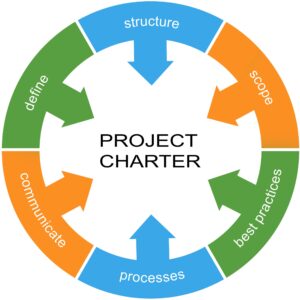Every project usually begins with a level of excitement or anticipation. But before you can actually get started, the project needs to get stakeholders’ approval so you can make sure everyone is on board with your vision. That’s where a project charter comes in.
A project charter is a document that sells a project to sponsors. With it, you can show a project’s viability and return on investment and get the green light to move forward.
Let’s learn a little more about why these charters matter and then we’ll show you how to create one.
Project Charter: A Definition
A project charter describes a project’s scope, development, and objectives. It also defines the roles and responsibilities of all stakeholders involved. The charter also establishes the project manager’s authority before the project kicks off.
Once key stakeholders approve it, the project charter initiates the project and becomes a contract between the project sponsor and the project manager.
Elements of a project charter
For your project charter to fulfill its purpose, it must include a few key elements.
- Definition: This section explains the purpose of the charter.
- Structure: This is a breakdown of when teams will complete the project and the major milestones teams must achieve.
- Scope, business case and project statement: This statement describes your project’s unique characteristics.
- Best practices: Here, you define the project’s success and list critical success factors.
- Processes: Describes the major project stakeholder requirements or critical project deliverables.
- Communicate: Defines all team and stakeholder roles and responsibilities and the communication plan
Here’s an example of a project charter to help illustrate the above:

Top Uses of A Project Charter in Project Management
The primary use of a project charter is of course, to authorize a project. But, charters aren’t just limited to the initiation phase. Use them as a reference document throughout a project’s lifecycle to ensure your work aligns with your objectives.
You can use a clear and concise charter to:
- Get project approval: Use your charter as an elevator pitch to sell the project to your stakeholders. Define broadly what their return on investment will be so they can approve the project.
- Serve as a reference point: I know we’ve already alluded to this, but it’s worth repeating. A project charter acts as your roadmap throughout the project’s life cycle. You can refer to it at any point to make sure there’s no scope creep or budget overruns.
- Hold stakeholders accountable: As mentioned earlier, a charter acts as a contract, holding everyone involved in the project accountable for their roles and responsibilities.
Project Charter Vs. Project Plans: What’s The Difference?
You’ve probably heard of (or created) a project plan before. It’s another key project document and not to be confused with the project charter. The two documents are different, each with its use.
One major difference is that a project charter is used to authorize the project, so you must prepare it before the project can start. On the other hand, a project plan is written right after the project has begun. It outlines the project scope and objectives based on the project charter.
The other difference between a project charter and a project plan relates to the primary purpose of each document. The project charter authorizes the project, and the project plan provides guidance on how to execute the activities that have been authorized.
Just as the purpose of these two documents differs, so do their intended audiences. The project charter is for stakeholders and the project manager, while the project plan is meant to guide the project team on the work they need to perform and how to do it.
How to Create A Project Charter
Every project is different and will have diverse needs. So it’s obvious that there’s no single best process to write a project charter.
However, if you’re not quite sure where to start, follow the eight steps below. This is a basic process you can follow and refine as you go.
Step 1: Name your project
Start by giving your project a name or title and make it as specific as possible. The project name should be descriptive so that whoever reads it can immediately tell why you want to implement this project. The title should also be easy to differentiate from other project charters. A good example is “Software Update to Improve UX for Mobile App.”
Step 2: Define the purpose, objective, and project specification
In this section, you need to explain:
The purpose of this project, the pain points it will alleviate, and how it will impact your organization.
What you how to accomplish with this project, and how it aligns with the overall organizational goals.
The work that needs to be done (and who will do it) for the project to succeed.
Step 3: State your budget
Here, explain in as much detail and with clarity how much the project will cost and where the money will come from. You could also list any additional resources you need to execute your plan.
Step 4: Outline the deliverables
Let the project sponsor know the product, service or result you’ll deliver when you finish the project. You can also include how you’ll measure the project’s success to determine whether you have accomplished your goals.
Step 5: Describe the scope and risks
Describe the project scope and the process to be followed to change the scope. Also, state known risks, constraints, and your proposed risk assessment and mitigation process throughout the project.
Step 6: Explain the timeframe or milestones
State the anticipated start and end dates of the project. The idea here is to let the project sponsors know when you plan to accomplish each stage of the project.
Step 7: Determine key stakeholders
You’ll be working with and reporting to several stakeholders (both internal and external). Do a stakeholder analysis and then list these individuals in this section of your project charter. This will help everyone involved in the project know the people affected by the project.
Step 8: Clarify team roles and responsibilities
Lastly, list the people involved in this project and their roles. You can use a RACI matrix to define key roles and responsibilities in a project.
Simplify Project Planning with Mission Control
Your project charter is the gateway to the project planning process. Once the relevant stakeholders approve it, you can move on to the planning stage.
As you plan your project, you need a reliable tool that lets you do all the planning—allocating resources, assigning tasks and deadlines, adding milestones, etc.—in one central place.
Naturally, we think Mission Control is the best tool for the job. With our software, you can plan and manage your project from start to finish.
Use our in-built Gantt charts to turn your project charter into a plan. With this interactive chart, you can project your entire timeline in visual form. It helps you visualize the project actions, milestones, and each task’s start and end dates. The entire project team can see how long each activity should last, overlapping activities, and dependencies.
Mission Control makes assigning tasks to team members easier and more efficient. Team members can add comments at the task level, making communication and collaboration within the software possible.
To wrap it up, creating and following a project charter is essential to a successful project. It helps increase clarity, improve communication, and ensure accountability. Further, a good project management tool will help bring your project charter to fruition.
Request a demo to see how Mission Control can help your organization create effective project charters and run successful projects!




